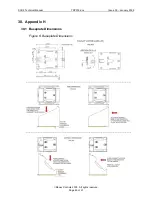
SCH2 Technical Manual TSP016.doc Issue 3.0 – January 2005
Money Controls 2005. All rights reserved.
Page 47 of 61
18. Electrical Noise - Physical Measures
The ccTalk protocol is not designed for long distance transfer but for local hook-up of various
peripherals within a machine cabinet. Typical cable lengths are likely to be of the order of a few
metres.
Various measures can be taken to minimise the effects of radiated and conducted noise on the
ccTalk bus.
¾
Use a good quality regulated power supply with mains filtering. The power
rating should be sufficient to handle a Serial Compact Hopper at maximum
surge current.
¾
Do not run the multi-drop bus cables directly next to noisy electrical components
if at all possible. These are typically motors, relays, VDU’s, fluorescent strip
lights etc. If problems are experienced consider the use of screened cable.
¾
Keep cable runs as short as possible.
¾
Make sure the ccTalk data line has an appropriate load resistor at the host end (
typically 1K to 10K pull-up to +5V ).
¾
Do not place too many peripherals on the bus - consider the loading effects of
each ccTalk interface circuit. The maximum number allowed will depend on the
host transceiver circuit.
19. Electrical Noise - Software Measures
There is a big difference in security and reliability terms between a good software
implementation of ccTalk and that of a poor one.
The following design points should be noted carefully…
Check each ccTalk reply packet for errors.
¾
Was there a low level byte framing error ?
¾
Were there the correct number of data bytes in the message ?
¾
Was the return destination address correct ?
¾
Was the checksum correct ?
¾
Was the peripheral source address the one expected ?
¾
Was the return header zero ?
If a reply is returned with an error then the ccTalk command can be re-transmitted as many
times as deemed appropriate - this is a key feature of ccTalk.
Note that the [ rx bad checksums ] byte returned by the ‘Request comms status variables’
command is useful for monitoring noise.
Summary of Contents for SCH2
Page 8: ......



































